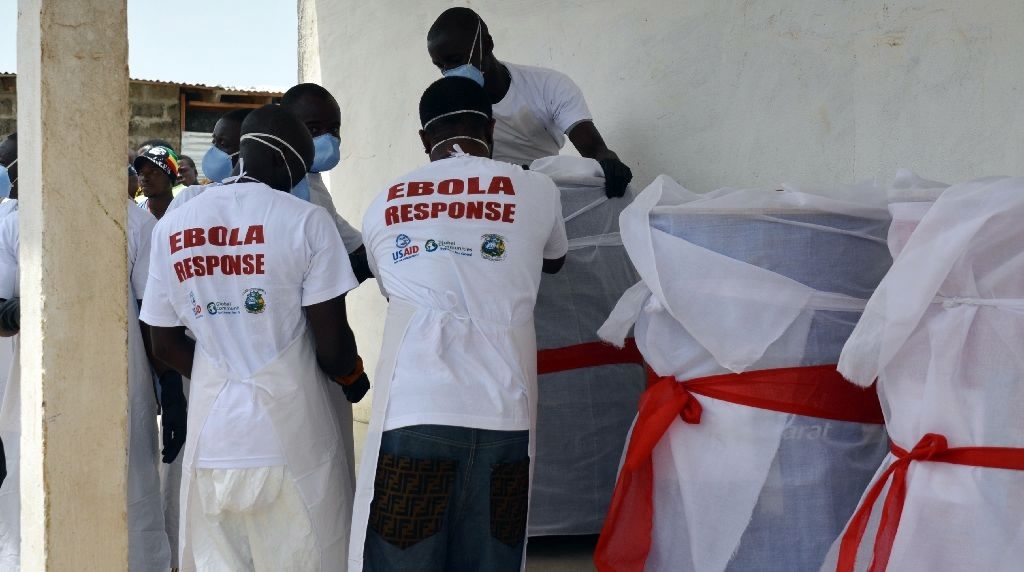
Tech & Sci
11:09, 23-Jun-2017
Safe burial methods averted thousands of Ebola deaths: study

Safe burial practices introduced by the Red Cross likely saved thousands of lives during the world’s worst outbreak of the deadly Ebola virus between 2013 and 2016, researchers said on Thursday.
In the first scientific study of Ebola victim burials, researchers found each unsafe burial had the potential to generate more than 2.5 secondary cases of Ebola infection.
The virus kills about 50 percent of those it infects on average, according to the World Health Organization.
People who treat and bury the bodies of the dead are especially at risk, as corpses are even more contagious than living Ebola patients.

Efforts of Red Cross volunteers to properly bury highly contagious bodies potentially averted as many as 10,452 Ebola cases /AFP Photo
Efforts of Red Cross volunteers to properly bury highly contagious bodies potentially averted as many as 10,452 Ebola cases /AFP Photo
The Red Cross safe burial program potentially averted between 1,411 and 10,452 secondary cases of infection during the West African outbreak, limiting its scale by as much as a third, estimated the study published in the journal PLOS Neglected Tropical Diseases.
Over 28,600 people were infected with the Ebola virus disease and more than 11,000 died in that epidemic, it added.
The Red Cross said the findings supported the “safe and dignified burial” practices conducted by its teams of trained local volunteers in virus-hit countries.
Those practices at times provoked furious reactions from some community members, as they went against traditional burial norms, which include touching and washing the body.

The bodies of Ebola victims were particularly toxic. /AFP Photo
The bodies of Ebola victims were particularly toxic. /AFP Photo
As a result, some volunteers conducting or even promoting safe burials were attacked, their vehicles vandalized and homes stoned.
"To respond effectively, we had to change our entire approach to dealing with people who had died and their families,” said Elhadj As Sy, secretary general of the International Federation of Red Cross and Red Crescent Societies (IFRC).
"We talked to communities and did our best to understand their beliefs and priorities. Ultimately, we earned their trust, and this was critical to success,” he added in a statement.
The study's findings have been used in the response to the most recent May Ebola outbreak in the Democratic Republic of Congo, Amanda McClelland, an IFRC officer for public health in emergencies, told the Thomson Reuters Foundation.

The work of the burial teams is thought to have played a major role in reducing the impact of the Ebola virus. /Reuters Photo
The work of the burial teams is thought to have played a major role in reducing the impact of the Ebola virus. /Reuters Photo
The Red Cross now conducts an assessment of cultural beliefs "very early on” to work out how its operating procedures can be adapted to accommodate traditional burial methods, she added.
The aid agency aims to build trust with religious and other local leaders before outbreaks occur. “We are able to explain how we need to do specific tasks and have them support us in working with the community,” McClelland said.
The Red Cross conducted about half of official safe burials in Sierra Leone and 100 percent in both Guinea and Liberia’s Montserrado County during the 2013-2016 epidemics.
While the number of infections that can be prevented through safe burial practices is significant, “greater impact would be achieved by early hospitalization of the primary case during acute illness”, the study noted.
(Source: Thomson Reuters Foundation)

SITEMAP
Copyright © 2018 CGTN. Beijing ICP prepared NO.16065310-3
Copyright © 2018 CGTN. Beijing ICP prepared NO.16065310-3